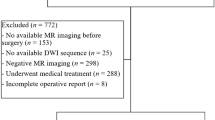Abstract
Purpose
To evaluate the best non-contrast magnetic resonance imaging (MRI) sequence and role of intravenous contrast administration in preoperative characterization and classification of perianal fistulae, keeping surgery as gold standard.
Methods
This prospective study comprised of forty-five consecutive patients with actively draining external perianal opening. MRI was performed on a 1.5 T scanner using non-contrast and contrast enhanced sequences in multiple planes. St. James’s University Hospital MRI based classification system was used to classify the fistulae into five grades. Taking surgery as gold standard, association between surgical and MRI findings was statistically analysed.
Results
Of the 45 patients recruited, forty were deemed eligible for inclusion. Mean age was 39.7 ± 11.7 years with male preponderance (M: F = 8:1). Commonest type was Grade 1 (40%). The best sequences in terms of overall accuracy were axial & coronal planes of contrast enhanced fat suppressed (FS) T1W turbo spin echo (TSE) (95.7%) followed by FS T2W TSE (94.1%) while sagittal T2W TSE sequence with or without fat suppression had the lowest accuracy (90.13%). The difference in overall diagnostic accuracy of FS T2W TSE and contrast enhanced FS T1W TSE sequence for evaluating perianal fistula was not statistically significant (p = 0.52). However, contrast study had a better accuracy in detecting internal openings and secondary tract of recurrent/ post-operative cases.
Conclusion
Best non-contrast MRI sequence is FS T2W TSE (axial and coronal). Non-contrast MRI is equally efficient to contrast study while evaluating primary/previously unoperated cases thereby eliminating the role of contrast in such cases. However, intravenous contrast should be administered for evaluating post-operative cases with recurrence.





Similar content being viewed by others
Data availability
Patients referred from department of surgery, Silchar Medical College and Hospital, Assam, India for radiological evaluation of perianal fistula.
References
Nelson R.L., Abcarian H. (2014) Epidemiology, Incidence and Prevalence of Fistula in Ano. In: Abcarian H. (eds) Anal Fistula. Springer, New York, NY
Sainio P. Fistula-in-ano in a defined population. Incidence and epidemiological aspects. Ann Chir Gynaecol. 1984;73(4):219‐224.
Seow-Choen, Phillips RK. Insights gained from the management of problematical anal fistulae at St. Mark's Hospital, 1984–88. The British Journal of Surgery. 1991 May;78(5):539–541. https://doi.org/10.1002/bjs.1800780508
Parks AG, Gordon PH, Hardcastle JD. A classification of fistula-in-ano. Br J Surg. 1976;63(1):1‐12. https://doi.org/10.1002/bjs.1800630102
de Miguel Criado J, del Salto LG, Rivas PF, del Hoyo LF a., Velasco LG, de las Vacas MIDP, et al. MR Imaging Evaluation of Perianal Fistulas: Spectrum of Imaging Features. Radiographics. 2012;32(1):175–94.
Morris J, Spencer JA, Ambrose NS. MR imaging classification of perianal fistulas and its implication for patient management. Radiographics. 2000; 20:623-35.
Laniado, M., Makowiec, F., Dammann, F. et al. Perianal complications of Crohn disease: MR imaging findings. Eur Radiol 7, 1035–1042 (1997).
Mahjoubi B, Haizadch Kharazi H, Mirzaei R, Moghimi A, Changizi A. Diagnostic accuracy of body coil MRI in describing the characteristics of perianal fistulas. Colorectal Dis. 2006;8(3):202‐207. https://doi.org/10.1111/j.1463-1318.2005.00899.x
Singh K, Singh N, Thukral CL, Singh KP, Bhalla V. Magnetic resonance imaging (MRI) evaluation of perianal fistulae with surgical correlation. J Clin Diagnostic Res. 2014;8(6):1–4.
Oliveira PG De, Sousa JB De, Almeida RM De, Saenger IF. Anal fistula : results of surgical treatment in a consecutive series of patients. J Coloproctology2012
Mohamed RE, Abo-Sheisha DM. Role of magnetic resonance imaging in pre-operative assessment of ano-rectal fistula. Egypt J Radiol Nucl Med 2014;45(1):35–47
Amjad MF, Muhammad AN. Perianal fistula; evaluation of the perianal fistula by MRI: our experience. Professional Med J 2015;22(8):1012-1019.
Agha ME, Eid M, Mansy H, Matarawy K, Wally M. Preoperative MRI of perianal fistula: Is it really indispensable? Can it be deceptive? Alexandria J Med 2013;49(2):133–44.
Vo D, Phan C, Nguyen L, Le H, Nguyen T, Pham H. The role of magnetic resonance imaging in the preoperative evaluation of anal fistulas. Sci Rep. 2019;9(1):17947. https://doi.org/10.1038/s41598-019-54441-2
Acknowledgements
Dr Pankaj Gupta, PGIMER, Chandigarh; Dr Debalok Chakraborty, SMCH, Silchar, Assam; Dr Angela Phukan, GNRC Medical, North Guwahati, Assam.
Funding
None.
Author information
Authors and Affiliations
Contributions
Both authors contributed to the study conception and design. Material preparation, data collection and analysis were performed by GCD under supervision of DKC. The first draft of the manuscript was written by GCD. Review and editing were done by GCD and DKC. Both authors read and approved the final manuscript.
Corresponding author
Ethics declarations
Conflict of interest
The authors declare that they have no conflicts of interest.
Ethical approval
Approval was obtained from the institutional ethics committee of Silchar Medical College and Hospital, Assam, India for this prospective study. Study was done over a period of one year. All procedures performed in studies involving human participants were in accordance with the ethical standards of the institutional ethics committee.
Consent to participate
Written informed consent was obtained from all individual participants included in the study.
Consent for publication
Patients signed informed consent regarding publishing their data and images.
Additional information
Publisher's Note
Springer Nature remains neutral with regard to jurisdictional claims in published maps and institutional affiliations.
Rights and permissions
About this article
Cite this article
Das, G.C., Chakrabartty, D.K. Best non-contrast magnetic resonance imaging sequence and role of intravenous contrast administration in evaluation of perianal fistula with surgical correlation. Abdom Radiol 46, 469–475 (2021). https://doi.org/10.1007/s00261-020-02616-1
Published:
Issue Date:
DOI: https://doi.org/10.1007/s00261-020-02616-1




